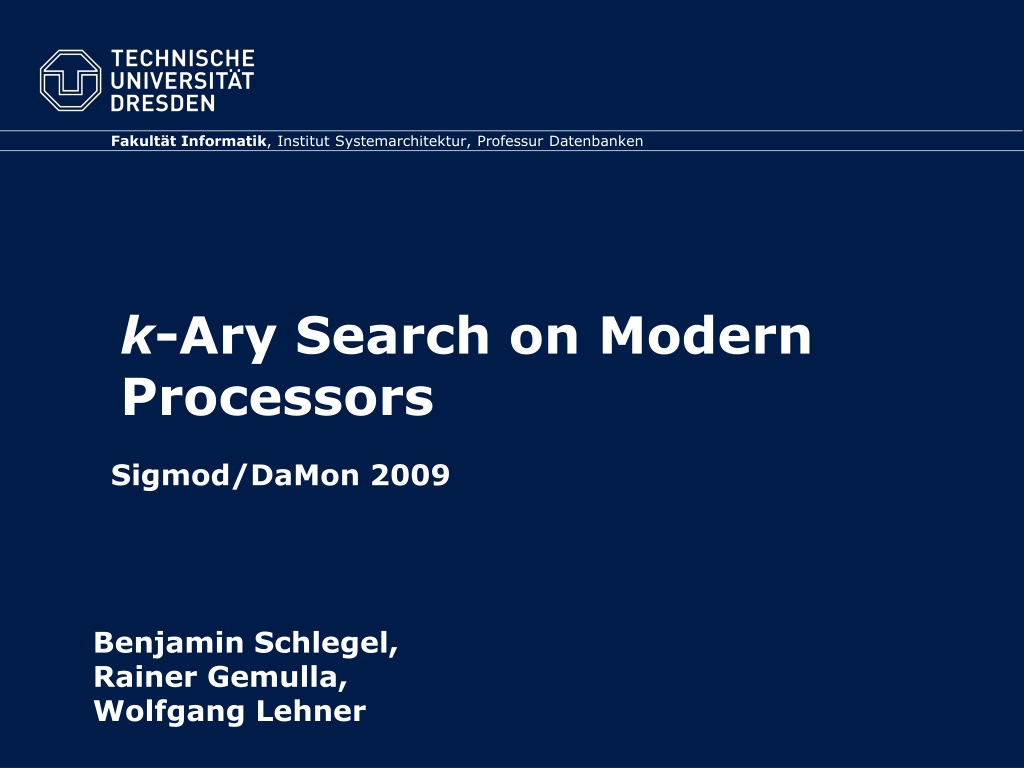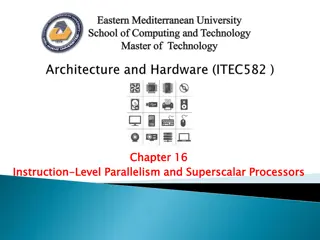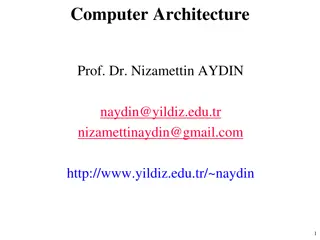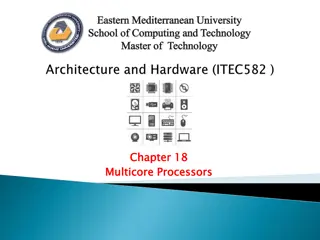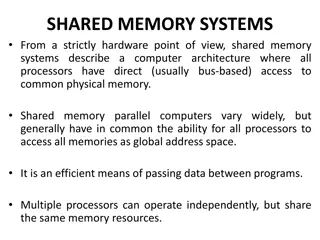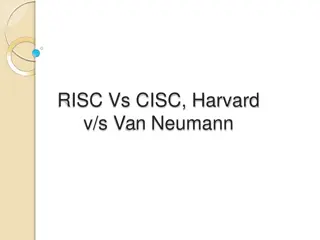k-Ary Search on Modern Processors
The presentation discusses the importance of searching operations in computer science, focusing on different types of searches such as point queries, nearest-neighbor key queries, and range queries. It explores search algorithms including linear search, hash-based search, tree-based search, and sort-based search, highlighting their complexities and performance characteristics. The agenda covers motivations, prerequisites, k-ary search strategies, experiments, and conclusions related to improving search operations on modern processors.
Download Presentation

Please find below an Image/Link to download the presentation.
The content on the website is provided AS IS for your information and personal use only. It may not be sold, licensed, or shared on other websites without obtaining consent from the author. Download presentation by click this link. If you encounter any issues during the download, it is possible that the publisher has removed the file from their server.
E N D
Presentation Transcript
Fakultt Informatik, Institut Systemarchitektur, Professur Datenbanken k-Ary Search on Modern Processors Sigmod/DaMon 2009 Benjamin Schlegel, Rainer Gemulla, Wolfgang Lehner
Motivation Searching Is a fundamental operation in computer science Many application areas (e.g. databases, ) Demand for high performance Different Types of Searching Point queries Nearest-neighbor key queries Range queries 6/28/2009 k-Ary Search on Modern Processors Slide 2
Motivation - Search algorithms Linear search Linear complexity Useful for small datasets Hash-based search Constant (best) complexity Additional space requirements Bad performance for range/nearest-key queries h(x) h(x) Tree-based search Logarithmic complexity Good update properties Sort-based search Logarithmic complexity No additional space requirements Cache-conscious range scans 6/28/2009 k-Ary Search on Modern Processors Slide 3
Agenda 1. Motivation 2. Prerequisites Binary search SIMDized Binary Search 3. k-Ary Search Sorted Array Linearized k-ary Search Tree 4. Experiments 5. Conclusion 6/28/2009 k-Ary Search on Modern Processors Slide 4
Binary search on a sorted array Idea Divide the search space in each iteration into two partitions Reduce the search space to one of the partitions Example Successful search for key 4 1 1 1 1 1 1 1 1 1 1 1 1 4 4 4 4 4 4 4 4 4 4 4 4 7 7 7 7 7 7 7 7 7 7 7 7 10 10 10 10 10 10 10 10 10 10 10 10 11 11 11 11 11 11 11 11 11 11 11 11 15 15 15 15 15 15 15 15 15 15 15 15 18 18 18 18 18 18 18 18 18 18 18 18 19 19 19 19 19 19 19 19 19 19 19 19 24 24 24 24 24 24 24 24 24 24 24 24 29 29 29 29 29 29 29 29 29 29 29 29 35 35 35 35 35 35 35 35 35 35 35 35 46 46 46 46 46 46 46 46 46 46 46 46 48 48 48 48 48 48 48 48 48 48 48 48 55 55 55 55 55 55 55 55 55 55 55 55 59 59 59 59 59 59 59 59 59 59 59 59 60 60 60 60 60 60 60 60 60 60 60 60 67 67 67 67 67 67 67 67 67 67 67 67 73 73 73 73 73 73 73 73 73 73 73 73 75 75 75 75 75 75 75 75 75 75 75 75 77 77 77 77 77 77 77 77 77 77 77 77 83 83 83 83 83 83 83 83 83 83 83 83 88 88 88 88 88 88 88 88 88 88 88 88 92 92 92 92 92 92 92 92 92 92 92 92 93 93 93 93 93 93 93 93 93 93 93 93 97 97 97 97 97 97 97 97 97 97 97 97 99 99 99 99 99 99 99 99 99 99 99 99 <1 <1 Hit Hit <7 <7 >1 >1 >7 >7 <15 <15 >15 >15 <48 <48 >48 >48 Analysis Worst-case iterations = log2(N+1) Number of keys Binary search 210 11 215 16 220 21 Problems No usage of modern CPU instruction sets 6/28/2009 k-Ary Search on Modern Processors Slide 5
Modern Processors Provide SIMD instructions Current: SSE, SSE2, SSE3, SSSE3, SSE4A, SSE4.2, Altivec, Future: AVX, SSE5, (k-1) parallel operation executions for one instruction Execution time similar to scalar operations For free with current processors SIMD instructions applicable for searching Loading Element-wise (e.g., compare two vectors) Horizontal (e.g., horizontal sum of a vector) 6/28/2009 k-Ary Search on Modern Processors Slide 6
SIMDized binary search on a sorted array Idea Same like plain binary search But: compares (k-1) subsequent keys per iteration Example Successful search for key 4 1 1 1 1 1 1 1 1 4 4 4 4 4 4 4 4 7 7 7 7 7 7 7 7 10 10 10 10 10 10 10 10 11 11 11 11 11 11 11 11 15 15 15 15 15 15 15 15 18 18 18 18 18 18 18 18 19 19 19 19 19 19 19 19 24 24 24 24 24 24 24 24 29 29 29 29 29 29 29 29 35 35 35 35 35 35 35 35 46 46 46 46 46 46 46 46 48 48 48 48 48 48 48 48 55 55 55 55 55 55 55 55 59 59 59 59 59 59 59 59 60 60 60 60 60 60 60 60 67 67 67 67 67 67 67 67 73 73 73 73 73 73 73 73 75 75 75 75 75 75 75 75 77 77 77 77 77 77 77 77 83 83 83 83 83 83 83 83 88 88 88 88 88 88 88 88 92 92 92 92 92 92 92 92 93 93 93 93 93 93 93 93 97 97 97 97 97 97 97 97 99 99 99 99 99 99 99 99 Hit Hit <15 <15 >18 >18 <48 <48 >55 >55 Analysis Worst-case iterations = log2(N/(k-1)+1) log2(N+1) - log2(k-1) Number of keys Binary search SIMDized binary search (k=5) 210 11 9 215 16 14 220 21 19 Advantage Constant reduction of log2(k-1) iterations 6/28/2009 k-Ary Search on Modern Processors Slide 7
Agenda 1. Motivation 2. Prerequisites Binary search SIMDized Binary Search 3. k-Ary Search Sorted Array Linearized k-ary Search Tree 4. Experiments 5. Conclusion 6/28/2009 k-Ary Search on Modern Processors Slide 8
k-ary search on a sorted array Idea Divide the search space into k partitions using k-1 separators Choose a partition depending of the comparison of the separators Example Successful search for key 4 7 7 7 7 7 7 7 7 35 35 35 35 35 35 35 35 88 88 88 88 88 88 88 88 1 1 1 1 1 1 1 1 4 4 4 4 4 4 4 4 10 10 10 10 10 10 10 10 11 11 11 11 11 11 11 11 15 15 15 15 15 15 15 15 18 18 18 18 18 18 18 18 19 19 19 19 19 19 19 19 24 24 24 24 24 24 24 24 29 29 29 29 29 29 29 29 46 46 46 46 46 46 46 46 48 48 48 48 48 48 48 48 55 55 55 55 55 55 55 55 59 59 59 59 59 59 59 59 60 60 60 60 60 60 60 60 67 67 67 67 67 67 67 67 73 73 73 73 73 73 73 73 75 75 75 75 75 75 75 75 77 77 77 77 77 77 77 77 83 83 83 83 83 83 83 83 92 92 92 92 92 92 92 92 93 93 93 93 93 93 93 93 97 97 97 97 97 97 97 97 99 99 99 99 99 99 99 99 Hit Hit <7 <7 >7 >7 <15 <15 >15 >15 <24 <24 >24 >24 <73 <73 >73 >73 Analysis Worst-case iterations = logk(N+1) Speedup = log2(k) Number of keys Binary search SIMDized binary search (k=5) k-ary search (k=5) 210 11 9 5 215 16 14 7 220 21 19 9 6/28/2009 k-Ary Search on Modern Processors Slide 9
k-ary search on a sorted array (cont.) Comparison step choosing the next partition Should require constant time independently of k Use horizontal vector sum of element-wise comparison result Example: search for key 77 (k=5): Partition 0 Partition 0 Partition 1 Partition 1 Partition 2 Partition 2 Partition 3 Partition 3 Partition 4 Partition 4 1 1 4 4 7 7 10 10 11 11 15 15 18 18 19 19 24 24 29 29 35 35 46 46 48 48 55 55 59 59 60 60 67 67 73 73 75 75 77 77 83 83 88 88 92 92 93 93 97 97 99 99 Separators Separators: : 15 15 35 35 60 60 83 83 Replicated search key: Replicated search key: 77 77 77 77 77 77 77 77 Lower Lower- -than result: result: than comparison comparison - -1 1 - -1 1 - -1 1 0 0 - -3 3 Vector sum: Vector sum: Loading step k-1 accesses to discontinuous memory locations in each iteration Solution 1: Scatter&Gather instructions (Larrabee, GPU, ) Solution 2: Searching on an alternative data layout 6/28/2009 k-Ary Search on Modern Processors Slide 10
k-ary search on a alternative data layout Idea Construct conceptually k-ary search tree Store node of k-ary search tree inorder in continuous array Example Mapping a sorted array on a linearized k-ary search tree 7 7 7 7 7 7 7 7 35 35 35 35 35 35 35 35 88 88 88 88 88 88 88 88 1 1 1 1 1 1 1 1 4 4 4 4 4 4 4 4 10 10 10 10 10 10 10 10 11 11 11 11 11 11 11 11 15 15 15 15 15 15 15 15 18 18 18 18 18 18 18 18 19 19 19 19 19 19 19 19 24 24 24 24 24 24 24 24 29 29 29 29 29 29 29 29 46 46 46 46 46 46 46 46 48 48 48 48 48 48 48 48 55 55 55 55 55 55 55 55 59 59 59 59 59 59 59 59 60 60 60 60 60 60 60 60 67 67 67 67 67 67 67 67 73 73 73 73 73 73 73 73 75 75 75 75 75 75 75 75 77 77 77 77 77 77 77 77 83 83 83 83 83 83 83 83 92 92 92 92 92 92 92 92 93 93 93 93 93 93 93 93 97 97 97 97 97 97 97 97 99 99 99 99 99 99 99 99 7 7 7 7 15 15 15 15 46 46 46 46 59 59 59 59 83 83 83 83 93 93 93 93 24 24 24 24 24 24 73 73 73 73 73 73 1 1 4 4 10 10 11 11 18 18 19 19 29 29 35 35 48 48 55 55 60 60 67 67 75 75 77 77 88 88 92 92 97 97 99 99 Successful search for key 4 24 24 24 24 24 24 24 24 73 73 73 73 73 73 73 73 7 7 7 7 7 7 7 7 15 15 15 15 15 15 15 15 46 46 46 46 46 46 46 46 59 59 59 59 59 59 59 59 83 83 83 83 83 83 83 83 93 93 93 93 93 93 93 93 1 1 1 1 1 1 1 1 4 4 4 4 4 4 4 4 10 10 10 10 10 10 10 10 11 11 11 11 11 11 11 11 18 18 18 18 18 18 18 18 19 19 19 19 19 19 19 19 29 29 29 29 29 29 29 29 35 35 35 35 35 35 35 35 48 48 48 48 48 48 48 48 55 55 55 55 55 55 55 55 60 60 60 60 60 60 60 60 67 67 67 67 67 67 67 67 75 75 75 75 75 75 75 75 77 77 77 77 77 77 77 77 88 88 88 88 88 88 88 88 92 92 92 92 92 92 92 92 97 97 97 97 97 97 97 97 99 99 99 99 99 99 99 99 Hit Hit <24 <24 >24 >24 <73 <73 >73 >73 <7 <7 >7 >7 <15 <15 >15 >15 Disadvantage: Range scans become expensive 6/28/2009 k-Ary Search on Modern Processors Slide 11
Agenda 1. Motivation 2. Prerequisites Binary search SIMDized Binary Search 3. k-Ary Search Sorted Array Linearized k-ary Search Tree 4. Experiments 5. Conclusion 6/28/2009 k-Ary Search on Modern Processors Slide 12
Experimental setup Setup Multiple runs with uniform distributed keys between 27and 225 Each run: search for 4096 uniform distributed keys Different key sizes: 4-byte integer and double precision floating point Algorithms Binary search (Bin) SIMDized binary search (Bin4) k-ary search on a sorted array (k-ary) k-ary search on a linearized k-ary search tree (k-ary-lt) Different platforms IBM Cell PPE (PowerPC-970 compatible) IBM Cell SPE (local store only / main memory) Intel Nehalem 920 2.66 GHz AMD Phenom 920 2.8 GHz AMD Phenom 920 2.8 GHz Setup Multiple runs with uniform distributed keys between 27and 225 Each run: search for 4096 uniform distributed keys Different key sizes: 4-byte integer and double precision floating point Algorithms Binary search (Bin) SIMDized binary search (Bin4) k-ary search on a sorted array (k-ary) k-ary search on a linearized k-ary search tree (k-ary-lt) Different platforms IBM Cell PPE (PowerPC-970 compatible) IBM Cell SPE (local store only / main memory) Intel Nehalem 920 2.66 GHz 6/28/2009 k-Ary Search on Modern Processors Slide 13
Results: Cell BE SPE 64 64- -bit Floating Point bit Floating Point 32 32- -bit Integer bit Integer 1.6x 1.6x 1.3x 1.3x 2.5x 2.5x 1.5x 1.5x Outcomes Binary search performs worst k-ary search on a linearized k-ary search tree performs best Occurring spikes result from non-aligned DMA-accesses 6/28/2009 k-Ary Search on Modern Processors Slide 14
Results: Intel Core i7 64 64- -bit Floating Point bit Floating Point 32 32- -bit Integer bit Integer 1.5x 1.5x 1.7x 1.7x 2.5x 2.5x 4x 4x Outcomes Binary search and SIMDized binary search perform similar Both k-ary search algorithms scale well for a huge number of keys 6/28/2009 k-Ary Search on Modern Processors Slide 15
Agenda 1. Motivation 2. Prerequisites Binary search SIMDized Binary Search 3. k-Ary Search Sorted Array Linearized k-ary Search Tree 4. Experiments 5. Conclusion 6/28/2009 k-Ary Search on Modern Processors Slide 16
Conclusion Current Situation Sort-based techniques are important Modern CPUs provide SIMD instructions Our Contribution k-ary search on Modern Processors Expected Future Scaling Number of keys Binary search SIMDized binary search (k=5) k-ary search (k=5) - SSE k-ary search (k=9) - AVX k-ary search (k=17) - Larrabee 210 11 9 5 4 3 215 16 14 7 5 4 220 21 19 9 7 5 6/28/2009 k-Ary Search on Modern Processors Slide 17
Fakultt Informatik, Institut Systemarchitektur, Professur Datenbanken k-Ary Search on Modern Processors Sigmod/DaMon 2009 Benjamin Schlegel, Rainer Gemulla, Wolfgang Lehner
